Maize Stalk Material for On-Site Treatment of Highly Polluted Leachate and Mine Wastewater
Abstract
:1. Introduction
2. Materials and Methods
2.1. Preparation of Biomaterial
2.2. Chemicals
2.3. Characterization Methods and Apparatus
2.4. Batch Adsorption Methodologies
2.5. Batch Experimental Procedure for Reutilization and Regeneration of Maize Stalk
2.6. Laboratory Batch Experimental Procedure for Mine Tailing Pond Decontamination
2.7. Analytical Methods
2.8. Sampling and Conservation of Mine Wastewater Samples
2.9. Column Adsorption Experiments for Mine Water Treatment
2.10. Column Adsorption Experiments for Synthetic Solution Evaluation
3. Results
3.1. Competitive Studies by Batch Technique
3.2. Batch Sorption Laboratory Experiments
3.3. Reutilization of Maize Stalk by Batch Studies
3.4. Efficient Cu(II) and Fe(III) Removal from Leachate Tailing Samples by Batch Technique
3.5. Applications of Maize Stalk in Column Experiment
3.5.1. Efficient Cu(II) and Fe(III) Removal from Mine Wastewater by Column Studies
3.5.2. Column Experiment Using Solutions of Cu(II) and Pb(II)
3.6. Maize Stalk Characterization after Mine Water Treatment
3.6.1. FTIR-ATR Studies
3.6.2. Thermal Analysis
3.6.3. Scanning Electron Microscopy (SEM)
4. Conclusions
Supplementary Materials
Author Contributions
Funding
Institutional Review Board Statement
Informed Consent Statement
Data Availability Statement
Conflicts of Interest
References
- Humelnicu, D.; Lazar, M.M.; Ignat, M.; Dinu, I.A.; Dragan, E.S.; Dinu, M.V. Removal of heavy metal ions from multi-component aqueous solutions by eco-friendly and low-cost composite sorbents with anisotropic pores. J. Hazard. Mater. 2020, 381, 120980. [Google Scholar] [CrossRef] [PubMed]
- Abdolali, A.; Ngo, H.H.; Guo, W.; Lee, D.; Tung, K.; Wang, X. Development and evaluation of a new multi-metal binding biosorbent. Bioresour. Technol. 2014, 160, 98–106. [Google Scholar] [CrossRef] [PubMed]
- Witek-Krowiak, A. Analysis of temperature-dependent bioadsorption of Cu2+ ions on sunflower hulls: Kinetics, equilib-rium and mechanism of the process. Chem. Eng. J. 2012, 192, 13–20. [Google Scholar] [CrossRef]
- Srisorrachatr, S. Modified sunflower seed husks for metal ions removal from wastewater. Chem. Eng. Trans. 2017, 57, 247–252. [Google Scholar]
- Joseph, L.; Jun, B.-M.; Flora, J.R.; Park, C.M.; Yoon, Y. Removal of heavy metals from water sources in the developing world using low-cost materials: A review. Chemosphere 2019, 229, 142–159. [Google Scholar] [CrossRef]
- Li, Y.; Zhao, B.; Zhang, L.; Han, R. Bioadsorption of copper ion by natural and modified wheat straw in fixed-bed column. Desalin. Water Treat. 2013, 51, 5735–5745. [Google Scholar] [CrossRef]
- Agarwal, M.; Singh, K. Heavy metal removal from wastewater using various adsorbents: A review. J. Water Reuse Desalin. 2017, 7, 387–419. [Google Scholar]
- George, Z.-K. Commercial Coffee Wastes as Materials for Adsorption of Heavy Metals from Aqueous Solutions. Materials 2012, 5, 1826–1840. [Google Scholar]
- Shiqiu, Z.; Xue, Y.; Le, L.; Meiting, J.; Kui, Z. Adsorption Behavior of Selective Recognition Functionalized Biochar to Cd(II) in Wastewater. Materials 2018, 11, 299. [Google Scholar]
- Gebretsadik, H.; Gebrekidan, A.; Demlie, L. Removal of heavy metals from aqueous solutions using Eucalyptus Camaldulensis: An alternate low cost adsorbent. Cogent Chem. 2020, 6, 1720892. [Google Scholar] [CrossRef]
- Saka, C.; Şahin, Ö.; Küçük, M.M. Applications on agricultural and forest waste adsorbents for the removal of lead (II) from contaminated waters. Int. J. Environ. Sci. Technol. 2012, 9, 379–394. [Google Scholar] [CrossRef] [Green Version]
- Zheng, L.; Dang, Z.; Yi, X.; Zhang, H. Equilibrium and kinetic studies of adsorption of Cd(II) from aqueous solution using modified corn stalk. J. Hazard. Mater. 2010, 176, 650–656. [Google Scholar] [CrossRef]
- Zheng, L.; Zhu, C.; Dang, Z.; Zhang, H.; Yi, X.; Liu, C. Preparation of cellulose derived from corn stalk and its application for cadmium ion adsorption from aqueous solution. Carbohydr. Polym. 2012, 90, 1008–1015. [Google Scholar] [CrossRef] [PubMed]
- Zheng, L.; Lu, G.; CAO, W.; Peng, D.; Zhu, C.; Lin, F.; Long, T.; Yalan, Z.; Zhoulin, L.; Yi, X. Modified Cellulose of Agricultural Residue Used for Removal of Heavy Metals and Oil: Technologies and Applications in Polymer Science: Research Advances, Practical Applications and Educational Aspects, 1st ed.; Mendez-Vilas, A., Solano, A., Eds.; Formatex Research Center S.L.: Badajoz, Spain, 2016; Corpus ID: 212698288. [Google Scholar]
- Vaughan, T.; Seo, C.W.; Marshall, W.E. Removal of selected metal ions from aqueous solution using modified corn cobs. Bioresour. Technol. 2001, 78, 133–139. [Google Scholar] [CrossRef]
- Benaïssa, H.; Elouchdi, M. Removal of copper ions from aqueous solutions by dried sunflower leaves. Chem. Eng. Process. Process. Intensif. 2007, 46, 614–622. [Google Scholar] [CrossRef]
- Alomá, I.; Martín-Lara, M.; Rodríguez, I.; Blázquez, G.; Calero, M. Removal of nickel(II) ions from aqueous solutions by bioadsorption on sugarcane bagasse. Taiwan Inst. Chem. Eng. 2012, 43, 275–281. [Google Scholar]
- Marin, N.M.; Batrinescu, G.; Stanculescu, I.; Constantin, L.A.; Cristea, I.; Ionescu, I.; Catrina, G.A. Experimental Model for Cu(II) and Fe(III) Adsorption from Synthetic Solutions Based on Maize Stalk. Rev. Chim. 2020, 71, 355–367. [Google Scholar] [CrossRef]
- Marin, N.M.; Pascu, L.F.; Stanculescu, I.; Iordache, O.; Jianu, D.; Petrescu, L.; Badea, I.A. Maize Stalk as Natural Ion Exchanger for Hazardous Pollutants. Rev. Chim. 2017, 68, 1726–1731. [Google Scholar] [CrossRef]
- Davoud, B.; Fredos, K.M.; Hossein, A. Adsorption Isotherm Studies of Pb(ll) Ions from Aqueous Solutions by Maize Stalks as a Cheap Biosorbent. J. Sci. Eng. Res. 2016, 3, 85–91. [Google Scholar]
- Jalali, M.; Aboulghazi, F. Sunflower stalk, an agricultural waste, as an adsorbent for the removal of lead and cadmium from aqueous solutions. J. Mater. Cycles Waste Manag. 2013, 15, 548–555. [Google Scholar] [CrossRef]
- Chen, Y.; Chen, Q.; Zhao, H.; Dang, J.; Jin, R.; Zhao, W.; Li, Y. Wheat Straws and Corn Straws as Adsorbents for the Removal of Cr (VI) and Cr (III) from Aqueous Solution: Kinetics, Isotherm, and Mechanism. ACS Omega 2020, 5, 6003–6009. [Google Scholar] [CrossRef] [PubMed]
- Štefušová, K.; Lovás, M.; Zubrik, A.; Matik, M.; Václavíková, M. Removal of Cd2+ and Pb2+ from aqueous solutions using bio-char residues. Nova Biotechnol. Chim. 2012, 11, 139–146. [Google Scholar] [CrossRef]
- Emandi, A.; Budrugeac, P.; Emandi, I.; Stanculescu, I.; Bugheanu, P. The assesment of the decayed lime wood polymeric components by TG and FT-IR parameters correlation. Int. J. Conserv. Sci. 2010, 1, 211–218. [Google Scholar]
- Chirila, L.; Popescu, A.; Cutrubinis, M.; Stanculescu, I.; Moise, V.I. The influence of gamma irradiation on natural dyeing properties of cotton and flax fabrics. Radiat. Phys. Chem. 2018, 145, 97–103. [Google Scholar] [CrossRef]
- Moise, I.V.; Manea, M.M.; Vasilca, S.; Pintilie, C.; Virgolici, M.; Cutrubinis, M.; Stanculescu, I.R.; Meltzer, V. The crosslinking behaviour of cellulose in gamma irradiated paper. Polym. Degrad. Stab. 2019, 160, 53–59. [Google Scholar] [CrossRef]
- Zhao, X.; Chen, J.; Chen, F.; Wang, X.; Zhu, Q.; Ao, Q. Surface characterization of corn stalk superfine powder studied by FTIR and XRD. Colloids Surf. B Biointerfaces 2013, 104, 207–212. [Google Scholar] [CrossRef]
- Shabangu, T.; Linganiso, L.Z.; Motaung, T.E.; Campus, K.; Setumo, M.V.; Koao, L.F. Comparison of Fibre from Maize Stalk Domains and Sugar Cane Bagasse. Wood Res. 2019, 64, 601–612. [Google Scholar]
- Alahmadi, N.S.; Betts, J.W.; Heinze, T.; Kelly, S.M.; Koschella, A.; Wadhawan, J.D. Synthesis and antimicrobial effects of highly dispersed, cellulose-stabilized silver/cellulose nanocomposites. RSC Adv. 2018, 8, 3646–3656. [Google Scholar] [CrossRef] [Green Version]
- Kamel, S.; Abou-Yousef, H.; Yousef, M.; El-Sakhawy, M. Potential use of bagasse and modified bagasse for removing of iron and phenol from water. Carbohydr. Polym. 2012, 88, 250–256. [Google Scholar] [CrossRef]
- Zhang, K.; Chen, T. Dried powder of corn stalk as a potential biosorbent for the removal of iodate from aqueous solution. J. Environ. Radioact. 2018, 190, 73–80. [Google Scholar] [CrossRef]
- Manzoor, K.; Ahmad, M.; Ahmad, S.; Ikram, S. Synthesis, Characterization, Kinetics, and Thermodynamics of EDTA-Modified Chitosan-Carboxymethyl Cellulose as Cu (II) Ion Adsorbent. ACS Omega 2019, 4, 17425–17437. [Google Scholar] [CrossRef] [PubMed] [Green Version]
- Kumar, G.V.S.R.P.; Malla, K.A.; Yerra, B.; Rao, K.S. Removal of Cu(II) using three low-cost adsorbents and prediction of adsorption using artificial neural networks. Appl. Water Sci. 2019, 9, 44. [Google Scholar] [CrossRef] [Green Version]
- Bandela, N.; Babrekar, M.; Jogdand, O.; Kaushik, G. Removal of copper from aqueous solution using local agricultural wastes as low cost adsorbent. J. Mater. Environ. Sci. 2016, 7, 1972–1978. [Google Scholar]
- Cretescu, I.; Soreanu, G.; Harja, M. A low-cost sorbent for removal of copper ions from wastewaters based on sawdust/fly ash mixture. Int. J. Environ. Sci. Technol. 2014, 12, 1799–1810. [Google Scholar] [CrossRef] [Green Version]
- Massimi, L.; Giuliano, A.; Astolfi, M.L.; Congedo, R.; Masotti, A.; Canepari, S. Efficiency Evaluation of Food Waste Materials for the Removal of Metals and Metalloids from Complex Multi-Element Solutions. Materials 2018, 11, 334. [Google Scholar] [CrossRef] [Green Version]
- Khalfa, L.; Sdiri, A.; Bagane, M.; Cervera, M.L. Multi-element modeling of heavy metals competitive removal from aqueous solution by raw and activated clay from the Aleg formation (Southern Tunisia). Int. J. Environ. Sci. Technol. 2020, 17, 2123–2140. [Google Scholar] [CrossRef]
- Cao, J.; Fei, D.; Tian, X.; Zhu, Y.; Wang, S.; Zhang, Y.; Mao, Q.; Sun, M. Novel modified microcrystalline cellulose-based porous material for fast and effective heavy-metal removal from aqueous solution. Cellulose 2017, 24, 5565–5577. [Google Scholar] [CrossRef]
- Song, S.-T.; Saman, N.; Johari, K.; Mat, H. Removal of Hg(II) from Aqueous Solution by Adsorption Using Raw and Chemically Modified Rice Straw As Novel Adsorbents. Ind. Eng. Chem. Res. 2013, 52, 13092–13101. [Google Scholar] [CrossRef]
- Nguyen, H.T.H.; Nguyen, B.Q.; Duong, T.T.; Bui, A.T.K.; Nguyen, H.T.A.; Cao, H.T.; Mai, N.T.; Nguyen, K.M.; Pham, T.T.; Kim, K.-W. Pilot-Scale Removal of Arsenic and Heavy Metals from Mining Wastewater Using Adsorption Combined with Constructed Wetland. Minerals 2019, 9, 379. [Google Scholar] [CrossRef] [Green Version]
- Hadi, M.; Samarghandi, M.R.; McKay, G. Simplified Fixed Bed Design Models for the Adsorption of Acid Dyes on Novel Pine Cone Derived Activated Carbon. Water Air Soil Pollut. 2010, 218, 197–212. [Google Scholar] [CrossRef]
- A Titanium Oxide Adsorbent for the Removal of Arsenic, Lead and Other Heavy Metals. Available online: https://www.lenntech.com/Data-sheets/Adsorbsia%20GTO.pdf (accessed on 1 July 2020).
- Zafar, M.N.; Aslam, I.; Nadeem, R.; Munir, S.; Rana, U.A.; Khan, S.U.-D. Characterization of chemically modified bio-sorbents from rice bran for bioadsorption of Ni (II). J. Taiwan Inst. Chem. Eng. 2015, 46, 82–88. [Google Scholar] [CrossRef]
- Pagnanelli, F.; Mainelli, S.; Vegliò, F.; Toro, L. Heavy metal removal by olive pomace: Biosorbent characterisation and equilibrium modelling. Chem. Eng. Sci. 2003, 58, 4709–4717. [Google Scholar] [CrossRef]

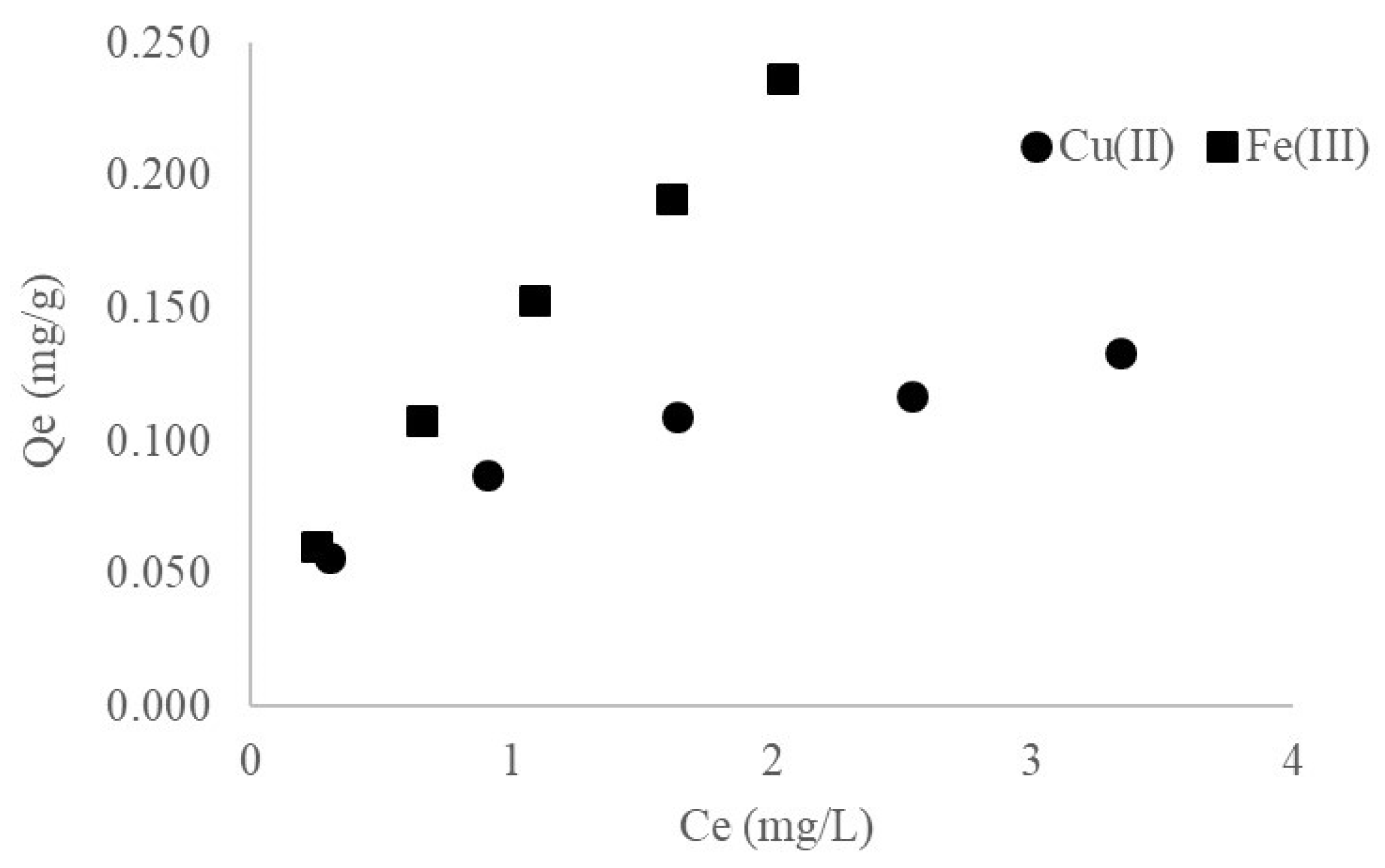
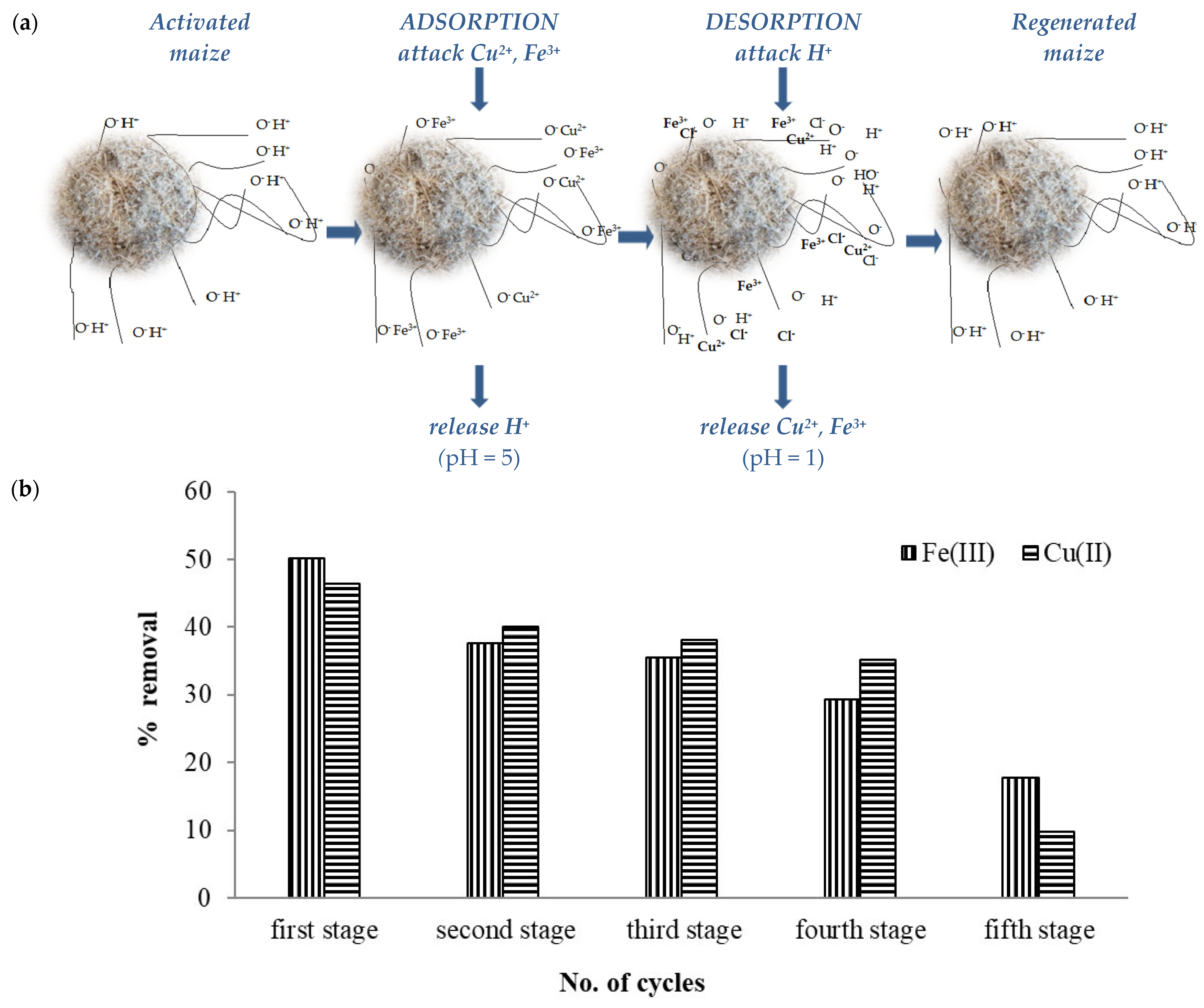

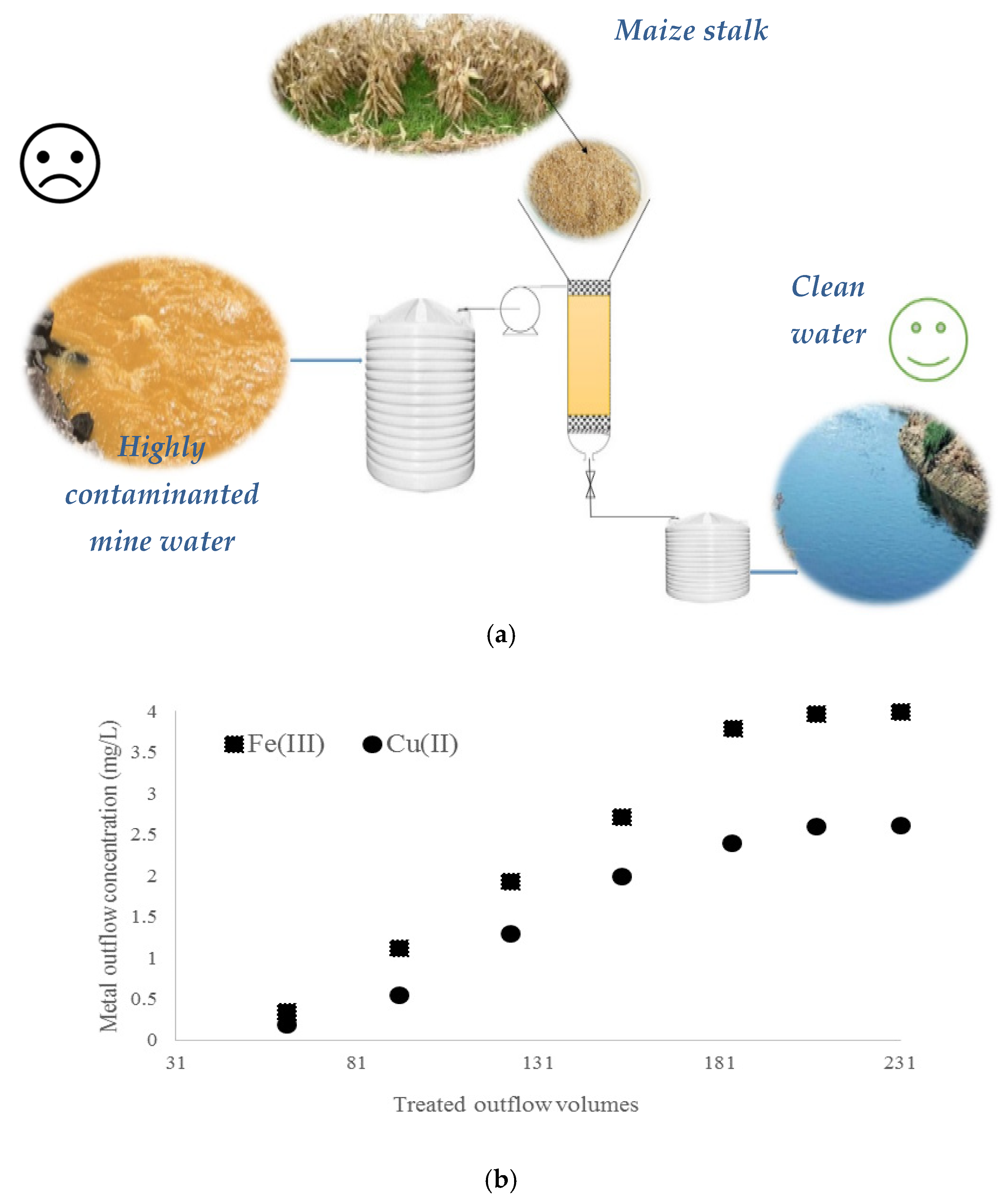
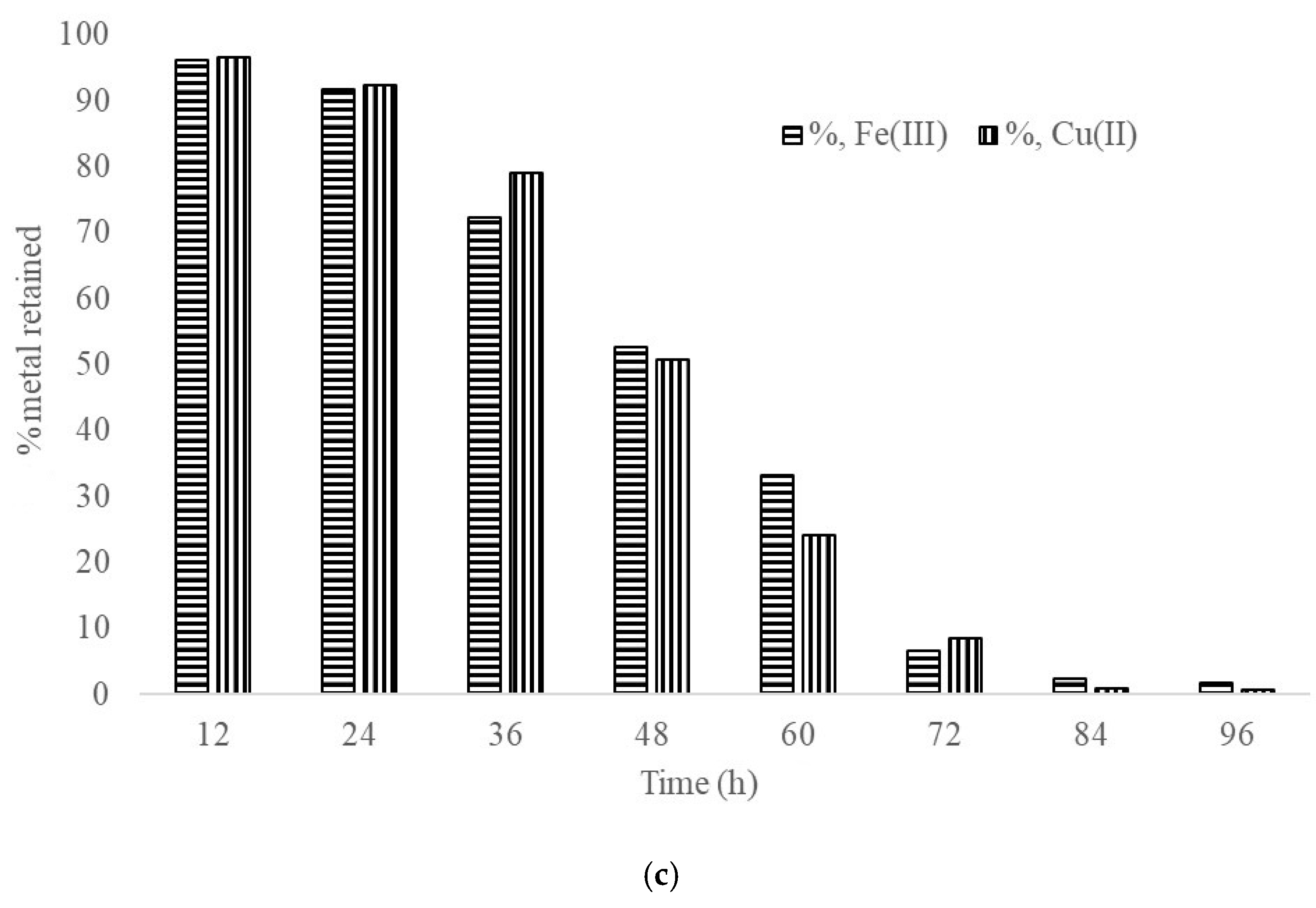

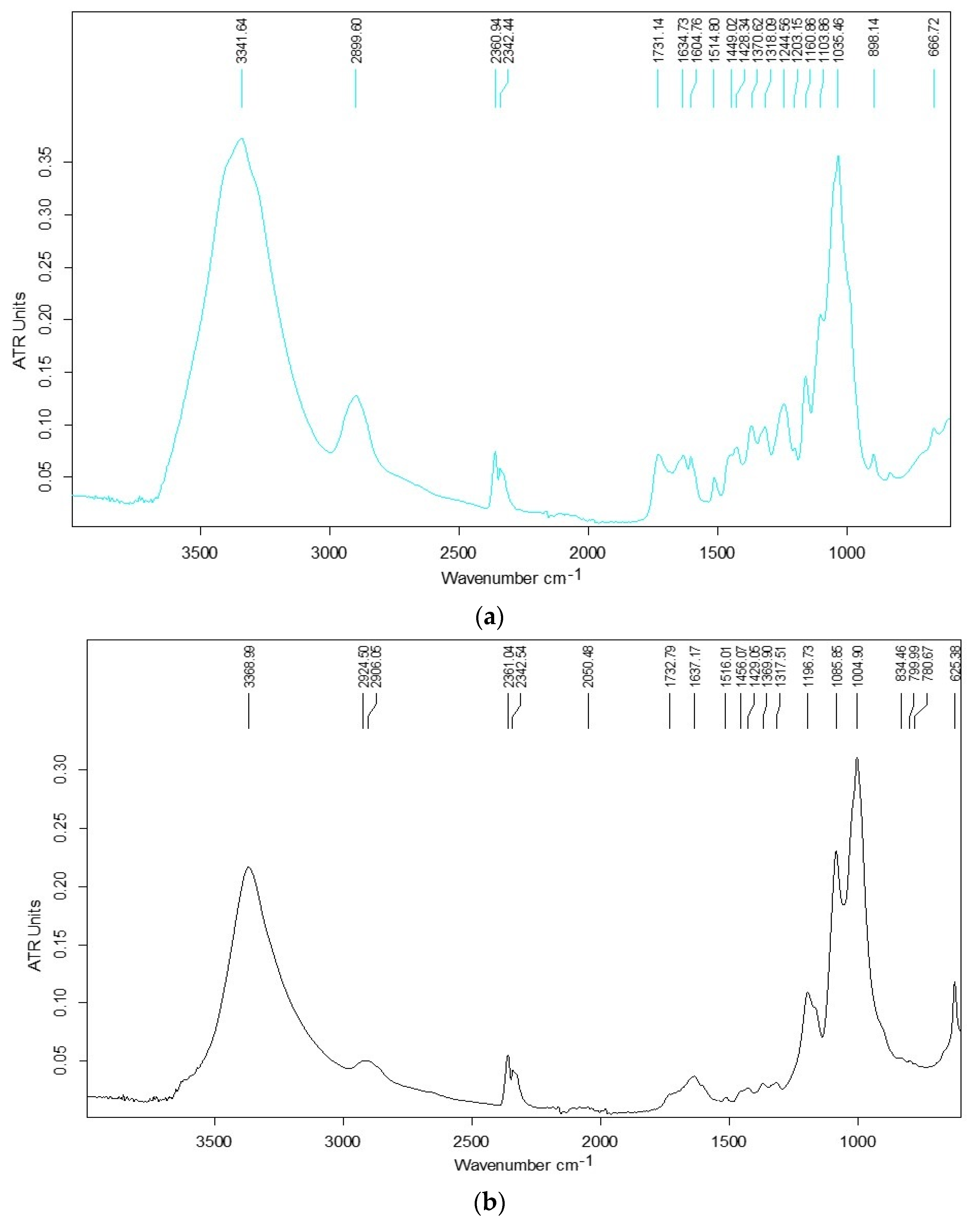
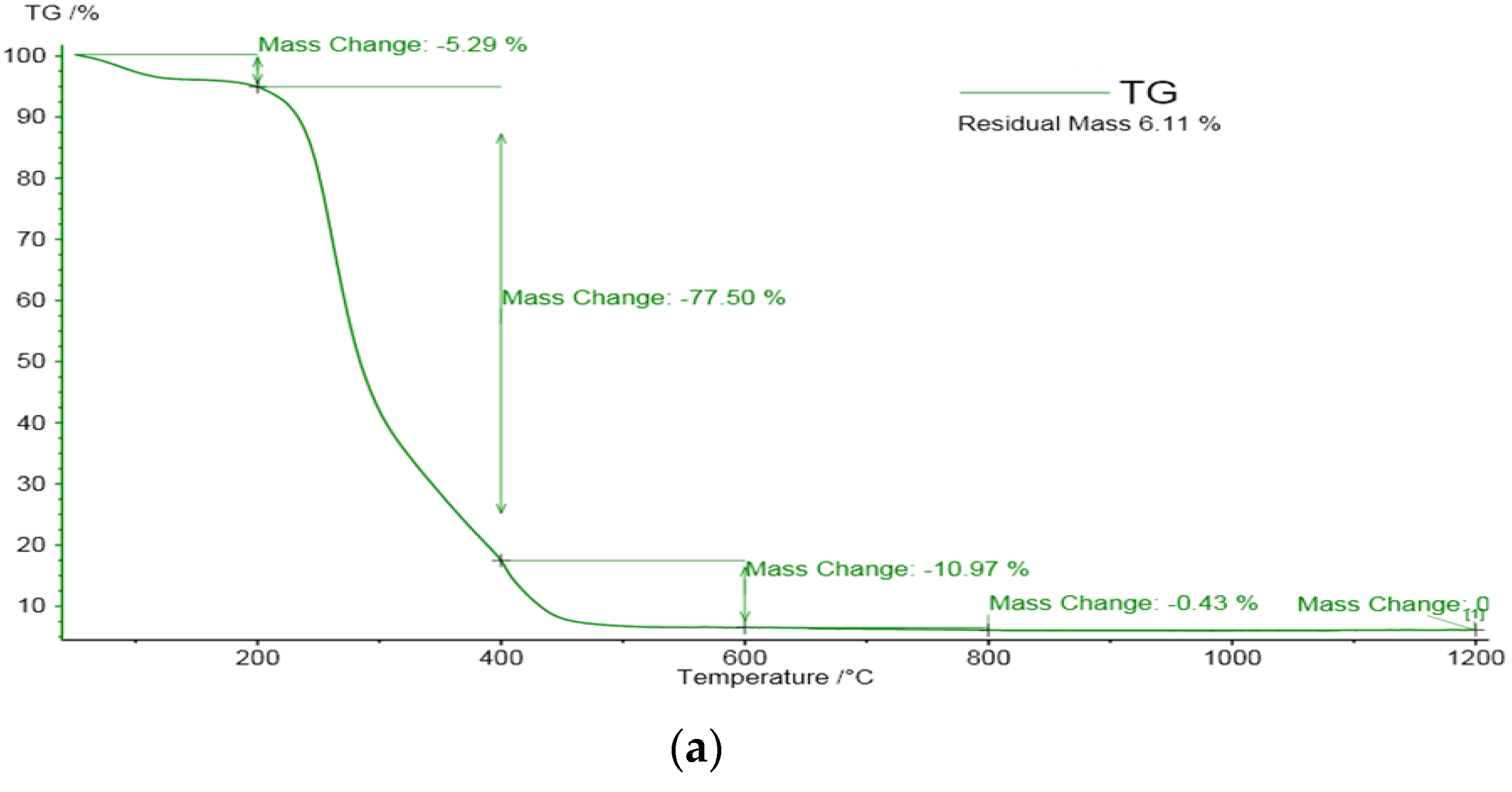
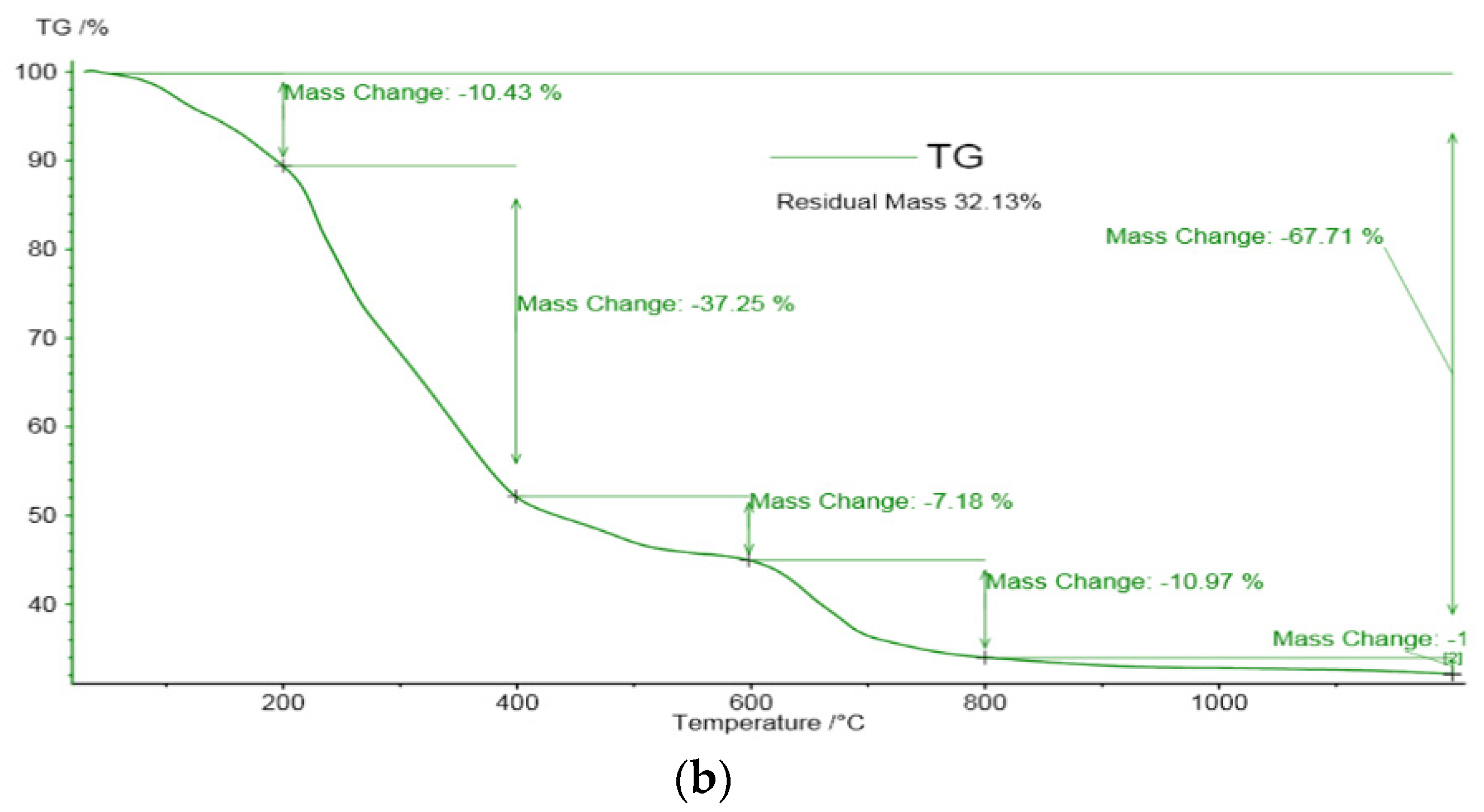

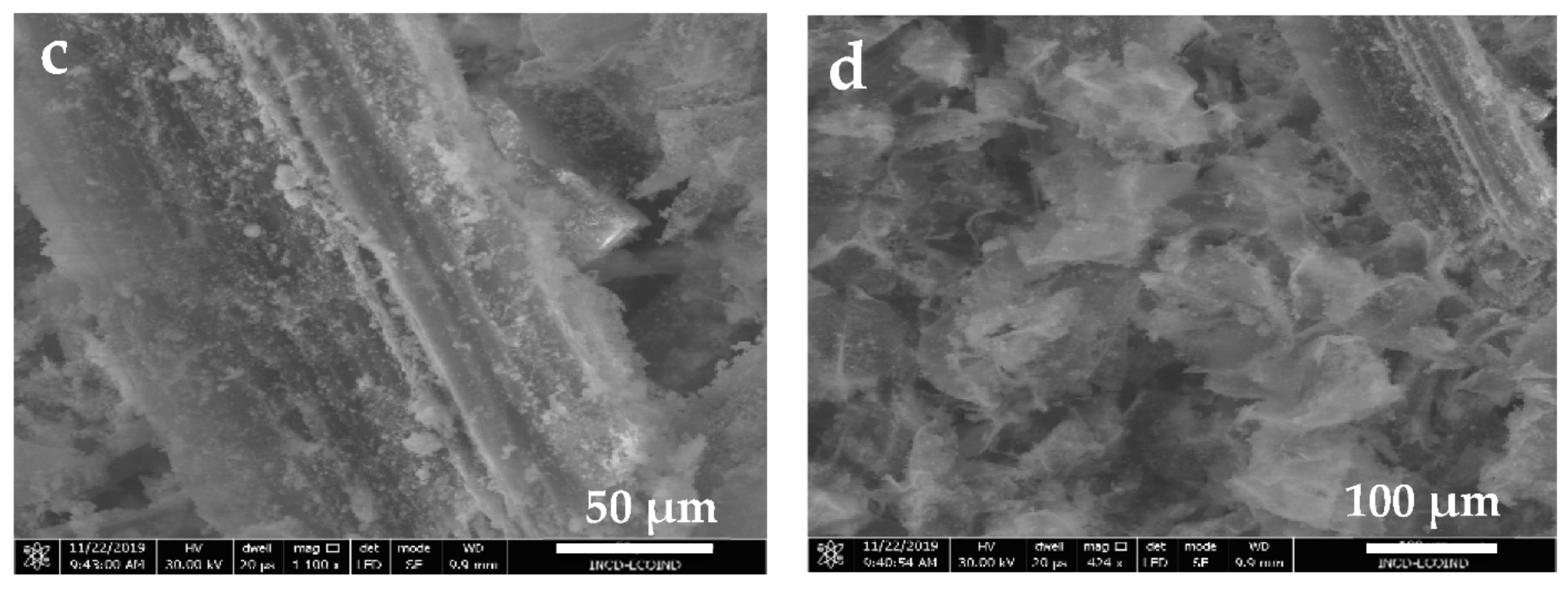
| Metal Ions | λ (nm) | Linear Regression Equation | Correlation Coefficient | Detection Limit (mg/L) | Determination Limit (mg/L) |
|---|---|---|---|---|---|
| Cu(II) | 324.75 | y = 0.1252x + 0.0007 | 0.9993 | 0.0010 | 0.0035 |
| Fe(III) | 248.33 | y = 0.0854x − 0.0004 | 0.9997 | 0.0020 | 0.0065 |
| Pb(II) | 283.31 | y = 0.0220x − 0.0021 | 0.9996 | 0.0012 | 0.0040 |
| Functional Groups | Maize Stalk Loaded with Metals from Mine Water (cm−1) | Maize Stalk Loaded with Metals from Tailing Solution (cm−1) |
|---|---|---|
| ν OH | 3341.64 | 3368.99 |
| ν CH | 2899.60 | 2906.05 |
| ν C=O | 1731.14 | 1732.79 |
| ν C=C | 1514.80 | 1516.01 |
| δ C–H | 1370.62 | 1369.90 |
| ν C–O | 1036.46 | 1004.00 |
Publisher’s Note: MDPI stays neutral with regard to jurisdictional claims in published maps and institutional affiliations. |
© 2021 by the authors. Licensee MDPI, Basel, Switzerland. This article is an open access article distributed under the terms and conditions of the Creative Commons Attribution (CC BY) license (http://creativecommons.org/licenses/by/4.0/).
Share and Cite
Marin, N.M.; Dinu, L.; Stanculescu, I.; Cristea, N.I.; Ionescu, A.I. Maize Stalk Material for On-Site Treatment of Highly Polluted Leachate and Mine Wastewater. Materials 2021, 14, 956. https://doi.org/10.3390/ma14040956
Marin NM, Dinu L, Stanculescu I, Cristea NI, Ionescu AI. Maize Stalk Material for On-Site Treatment of Highly Polluted Leachate and Mine Wastewater. Materials. 2021; 14(4):956. https://doi.org/10.3390/ma14040956
Chicago/Turabian StyleMarin, Nicoleta Mirela, Laurentiu Dinu, Ioana Stanculescu, Nicolae Ionut Cristea, and Alexandra Ioana Ionescu. 2021. "Maize Stalk Material for On-Site Treatment of Highly Polluted Leachate and Mine Wastewater" Materials 14, no. 4: 956. https://doi.org/10.3390/ma14040956







